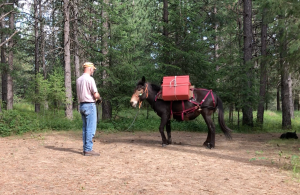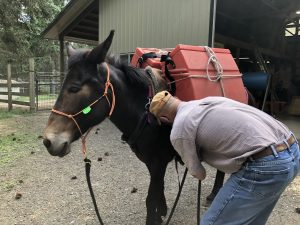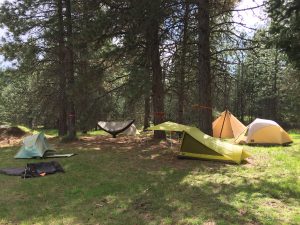Building Confidence on the Trail and in Camp.
We trail ride and camp with our horses because there is nothing better in the world than enjoying the outdoors with our furry friends. Yet, it’s not always perfect.
When you’re in any situation (riding or otherwise), the more confident you are, the less likely you are to find yourself in trouble. Confidence also helps you feel more capable of controlling yourself and your horse, or mule, in stressful situations.
These are the tools that I use to improve my confidence. They’ll work for you as well.
Confidence in the saddle:
Go back to basics and get back on the ground. Many riders, myself included, with confidence issues tend to focus on the problems they’re having when they’re in the saddle, when in reality the issues begin on the ground. Take for example a horse that doesn’t stand quietly when you get in the saddle. It can be intimidating as well as an inconvenience and a safety issue. Issues like this have one common denominator. The animal doesn’t respect you.
 This process of earning your horse’s respect starts on the ground as you teach your horse to respond to your cues. As your horse learns to respect your rules through groundwork, you’ll see those same lessons carry over to your riding. A friend and mentor of mine, Ty Evans, elucidated this concept with this question. “If your mule doesn’t listen to you when you’re on the ground, why on earth would it listen when you’re on its back?”
This process of earning your horse’s respect starts on the ground as you teach your horse to respond to your cues. As your horse learns to respect your rules through groundwork, you’ll see those same lessons carry over to your riding. A friend and mentor of mine, Ty Evans, elucidated this concept with this question. “If your mule doesn’t listen to you when you’re on the ground, why on earth would it listen when you’re on its back?”
Groundwork is about establishing better control over your horse’s movements. As your animal learns to recognize your cues and to move accordingly he’ll gain a better understanding of your expectations and be used to following your lead. As you teach your horse to respect your rules through groundwork, you’ll see those lessons carry over to your riding. You’ll also grow more confident in the saddle with a clear understanding of how your horse moves and responds.
Who’s the Leader?
 In your relationship with your horse, there needs to be a leader and that leader needs to be you. You’re the only one in the partnership who knows the plan. After all you’re the one who knows whether you’re turning right or left at the next trail junction, where to safely cross the river, or where camp is for the night.
In your relationship with your horse, there needs to be a leader and that leader needs to be you. You’re the only one in the partnership who knows the plan. After all you’re the one who knows whether you’re turning right or left at the next trail junction, where to safely cross the river, or where camp is for the night.
The key to communicating with your horse and making yourself the leader—is education and repetition. Start at the beginning and take it slowly. Pay as much attention to the small details of riding as you do to your animal’s health. Cocoa wants to take a step when I’m loading the pack saddle? Fine. We’ll practice moving our feet until she’s re-learned that when the saddles are out it’s work time. We practice this at home so that it’s not an issue at the trailhead.
Confidence when Camping:
Practice, practice, practice. You might have a ride in mind that involves camping midway through, or there could just be an urge to spend some quality time at an established horse camp. Camping adventures give you an incredible diversity in the options for your trips, allowing you to access areas that may not be possible to you when home is your base camp. It’s also really easy to make mistakes that can derail your enjoyment. That’s why it’s important to feel confident in what you’re doing so you can concentrate on the reasons why you decided to do this in the first place. The sense of achievement from being in the wide open and possibly having pushed yourself out of your comfort zone is incredible!
 My first camping trip of every year is in the back pasture. I’d much rather try a new piece of gear, have an equipment failure, or find that I’ve misplaced a vital piece of gear, close to home rather than an hour, or more, away. We become more confident with every additional minute spent in the saddle. We also become more confident in camp through experience camping. When I set up camp in the back pasture I pretend that I’m 20 miles inside the Bob Marshall Wilderness Complex, not 800 feet from a hot shower. Set up camp the same way that you would in a “real” situation and you’ll soon learn what works and what doesn’t.
My first camping trip of every year is in the back pasture. I’d much rather try a new piece of gear, have an equipment failure, or find that I’ve misplaced a vital piece of gear, close to home rather than an hour, or more, away. We become more confident with every additional minute spent in the saddle. We also become more confident in camp through experience camping. When I set up camp in the back pasture I pretend that I’m 20 miles inside the Bob Marshall Wilderness Complex, not 800 feet from a hot shower. Set up camp the same way that you would in a “real” situation and you’ll soon learn what works and what doesn’t.
Don’t Hurry:
Slow is smooth, smooth is fast. Don’t rush to failure. When you’re addressing a new skill set take your time. Be slow and deliberate. When we rush into situations that we’re not ready for, we forget to check the fine points and we all know it’s the details that count. Start at the beginning and gradually work your way out. If you’ve never horse camped before don’t start planning a 2 week pack-trip right away. Work up to those bucket list adventures in small steps. Practice makes proficient, and proficient leads to perfection. Take your time and really practice and work towards your goal, whatever it is. Before you move up, your current skills should be smooth and relaxed for you and your horse. If you’re confident, your horse is confident, you’ve done the basics, then you’re probably ready. Be deliberate, don’t rush to failure, acknowledge the progress you’ve made, clap for yourself, and keep pushing forward!
Never Mind the Mistakes:
Mistakes are proof that you are trying. Despite what some on social media may declare; everyone makes mistakes. The key is learning from those mistakes so that we don’t make the same ones again.
As always for more practical information on trail riding and camping with horses, as well as the world’s largest guide to horse trails and camps, visit us at www.TrailMeister.com


